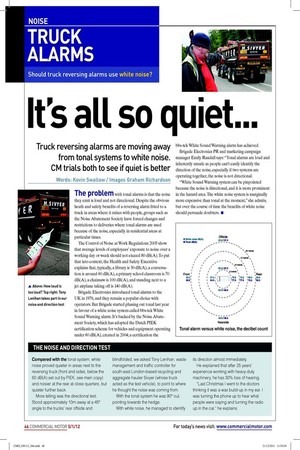NOISE
Page 38

If you've noticed an error in this article please click here to report it so we can fix it.
TRUCK ALARMS
Should truck reversing alarms use white noise?
It’s all so quiet...
Truck reversing alarms are moving away from tonal systems to white noise. CM trials both to see if quiet is better
Words: Kevin Swallow / Images Graham Richardson
The problem with tonal alarms is that the noise they emit is loud and not directional. Despite the obvious heath and safety beneits of a reversing alarm itted to a truck in areas where it mixes with people, groups such as the Noise Abatement Society have forced changes and restrictions to deliveries where tonal alarms are used because of the noise, especially in residential areas at particular times.
The Control of Noise at Work Regulations 2005 show that average levels of employees’ exposure to noise over a working day or week should not exceed 80 dB(A). To put that into context, the Health and Safety Executive explains that, typically, a library is 30 dB(A), a conversation is around 60 dB(A), a primary school classroom is 70 dB(A), a chainsaw is 100 dB(A), and standing next to a jet airplane taking off is 140 dB(A).
Brigade Electronics introduced tonal alarms to the UK in 1976, and they remain a popular choice with operators. But Brigade started phasing out tonal last year in favour of a white noise system called bbs-tek White Sound Warning alarm. It’s backed by the Noise Abatement Society, which has adopted the Dutch PIEK certiication scheme for vehicles and equipment operating under 60 dB(A), created in 2004; a certiication the bbs-tek White Sound Warning alarm has achieved.
Brigade Electronics PR and marketing campaign manager Emily Randall says: “Tonal alarms are loud and inherently unsafe as people can’t easily identify the direction of the noise, especially if two systems are operating together, the noise is not directional.
“White Sound Warning system can be pinpointed because the noise is directional, and it is more prominent in the hazard area. The white noise system is marginally more expensive than tonal at the moment,” she admits, but over the course of time the beneits of white noise should persuade doubters. n
THE NOISE AND DIRECTION TEST
Compared with the tonal system, white noise proved quieter in areas next to the reversing truck (front and sides, below the 60 dB(A) set out by PIEK, see main copy) and noisier at the rear at close quarters, but quieter further back.
More telling was the directional test. Stood approximately 10m away at a 45° angle to the trucks’ rear offside and blindfolded, we asked Tony Lenihan, waste management and traffic controller for south-east London-based recycling and aggregate haulier Sivyer (whose truck acted as the test vehicle), to point to where he thought the noise was coming from.
With the tonal system he was 90° out, pointing towards the hedge.
With white noise, he managed to identify its direction almost immediately.
He explained that after 25 years’ experience working with heavy-duty machinery, he has 30% loss of hearing.
“Last Christmas I went to the doctors thinking it was a wax build-up in my ear. I was turning the phone up to hear what people were saying and turning the radio up in the car,” he explains.













































